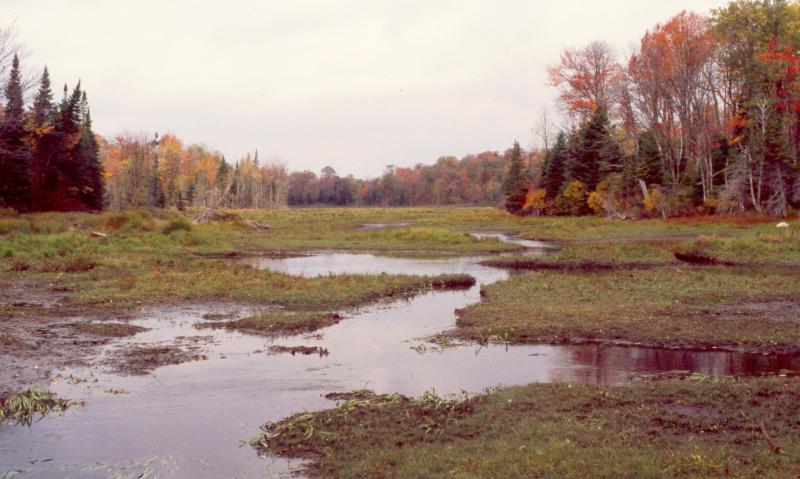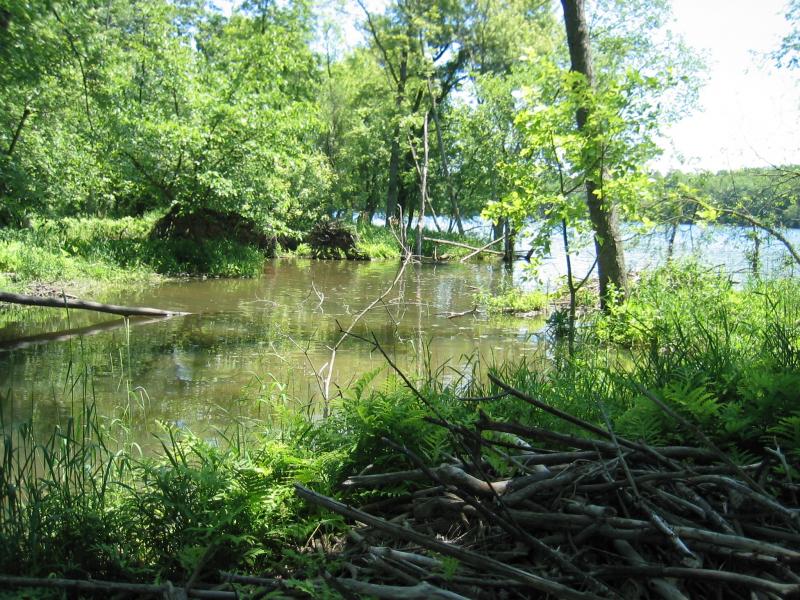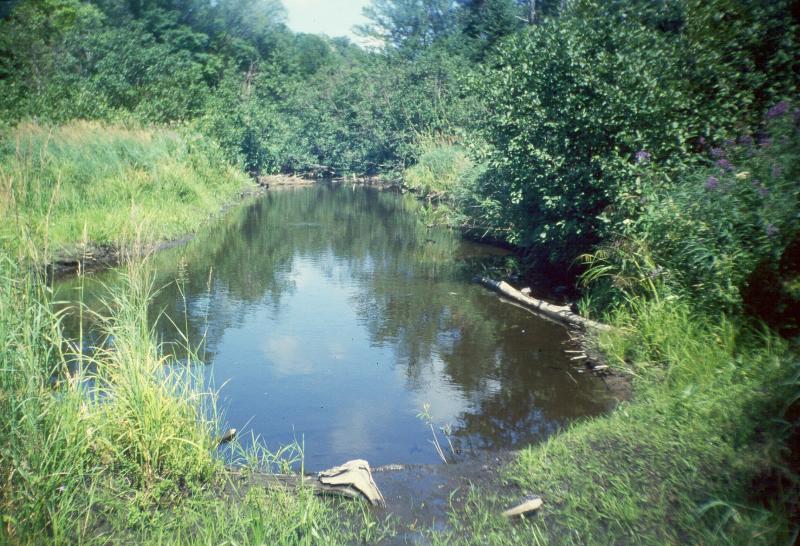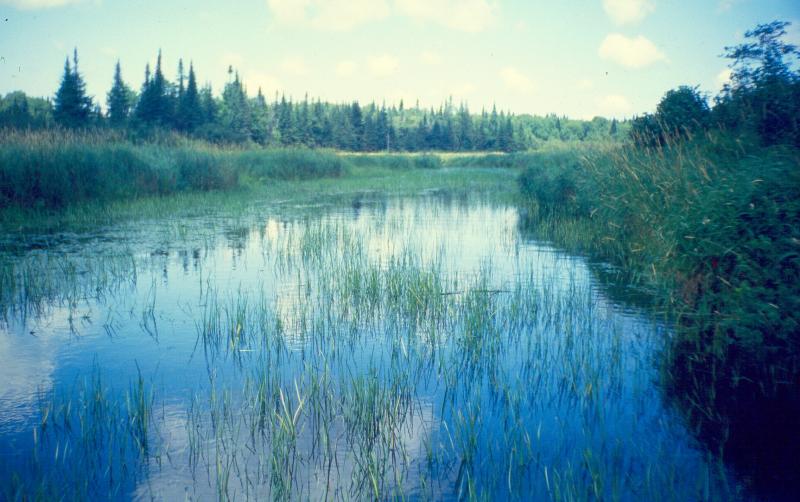Marsh Headwater Stream
- System
- Riverine
- Subsystem
- Natural Streams
- State Protection
- Not Listed
Not listed or protected by New York State.
- Federal Protection
- Not Listed
- State Conservation Status Rank
- S4
Apparently Secure in New York - Uncommon in New York but not rare; usually widespread, but may be rare in some parts of the state; possibly some cause for long-term concern due to declines or other factors.
- Global Conservation Status Rank
- G4
Apparently Secure globally - Uncommon in the world but not rare; usually widespread, but may be rare in some parts of its range; possibly some cause for long-term concern due to declines or other factors.
Summary
Did you know?
The largest rodents in North America, American beavers (Castor canadensis), commonly construct dams across marsh headwater streams. By damming these streams, beavers raise water levels and create a protective moat around their lodge; within the deepest waters of their impoundments, they store food for the winter. When the dam is breached and water slowly drains from the pond, wetland plants colonize the exposed edges; once the water drains enough to be limited to the old stream channel, the area that was once a beaver pond has cycled back into a marsh headwater stream.
State Ranking Justification
There are several thousand occurrences statewide. Many documented occurrences have good viability and are protected on public land or private conservation land. This community has statewide distribution, and includes several high quality examples. The current trend of this community is probably stable for occurrences on public land, or declining slightly elsewhere due to moderate threats related to development pressure or alteration to the natural hydrology.
Short-term Trends
The number and miles of marsh headwater streams in New York have probably remained stable in recent decades as a result of water quality regulations. Several examples have shown improvement in water quality in recent decades attributed to improved treatment of municipal and industrial waste (Bode et al. 1993).
Long-term Trends
The number and miles of marsh headwater streams in New York are probably comparable to historical numbers, but the water quality of several of these streams likely declined significantly prior to the enforcement of water quality regulations (New York State Department of Environmental Conservation, Division of Water 2000).
Conservation and Management
Threats
Marsh headwater streams are threatened by development and its associated run-off (e.g., residential, agricultural, roads, bridges), recreational overuse (e.g., ATVs, intensive fish stocking and removal, adjacent camping), and habitat alteration in the adjacent landscape (e.g., logging, pollution run-off). Alteration to the natural hydrology is also a threat to this community (e.g., impoundments, blocked culverts, stream channelization, water diversions, bank stabilization). Reduction in water quality is a threat to marsh headwater streams (e.g., siltation, trash, turbidity, septic/nutrient run-off, pesticides, water temperature increase). A few marsh headwater streams are threatened by invasive, non-native plants and animals.
Conservation Strategies and Management Practices
Where practical, establish and maintain a riparian buffer to reduce storm-water, pollution, and nutrient run-off, while simultaneously capturing sediments before they reach the stream. Buffer width should take into account the erodibility of the surrounding soils, slope steepness, and current land use. If possible, minimize the number and size of impervious surfaces in the surrounding landscape. Avoid habitat alteration within the stream and surrounding landscape. For example, roads should not be routed through the riparian buffer area. If the stream must be crossed, then bridges and boardwalks are preferred over filling and culverts. Restore past impacts, such as removing obsolete impoundments and hardened shorelines in order to restore the natural hydrology. Prevent the spread of invasive exotic species into the river through appropriate direct management, and by minimizing potential dispersal corridors.
Development and Mitigation Considerations
When considering road construction and other development activities, minimize actions that will change what water carries and how water travels to this community, both on the surface and underground. Water traveling over-the-ground as run-off usually carries an abundance of silt, clay, and other particulates during (and often after) a construction project. While still suspended in the water, these particulates make it difficult for aquatic animals to find food; after settling to the bottom of the stream, these particulates bury small plants and animals and alter the natural functions of the community in many other ways. Thus, road construction and development activities near this community type should strive to minimize particulate-laden run-off into this community. Water traveling on the ground or seeping through the ground also carries dissolved minerals and chemicals. Road salt, for example, is becoming an increasing problem both to natural communities and as a contaminant in household wells. Fertilizers, detergents, and other chemicals that increase the nutrient levels in wetlands result in algae blooms and eventually an oxygen-depleted environment where few animals can live. Herbicides and pesticides often travel far from where they are applied and have lasting effects on the quality of the natural community. So, road construction and other development activities should strive to consider: 1. how water moves through the ground, 2. the types of dissolved substances these development activities may release, and 3. how to minimize the potential for these dissolved substances to reach this natural community.
Inventory Needs
Survey for occurrences statewide to advance documentation and classification of marsh headwater streams. A statewide review of marsh headwater streams is desirable. Continue searching for large stream systems in good condition (A- to AB-ranked).
Research Needs
Research composition of marsh headwater streams statewide in order to characterize variations. Collect sufficient quantitative data to support the recognition of several distinct marsh headwater streams based on composition and by ecoregion.
Rare Species
- Cordulegaster obliqua (Arrowhead Spiketail) (guide)
- Etheostoma exile (Iowa Darter) (guide)
- Eurycea longicauda (Longtail Salamander) (guide)
- Lanthus vernalis (Southern Pygmy Clubtail) (guide)
- Myriophyllum farwellii (Farwell's Water Milfoil) (guide)
- Notropis heterodon (Blackchin Shiner) (guide)
- Plantago cordata (Heart-leaved Plantain) (guide)
- Poa paludigena (Slender Marsh Blue Grass) (guide)
- Podilymbus podiceps (Pied-billed Grebe) (guide)
- Polemonium vanbruntiae (Jacob's Ladder) (guide)
- Potamogeton hillii (Hill's Pondweed) (guide)
- Potamogeton pulcher (Spotted Pondweed) (guide)
- Potamogeton x ogdenii (Ogden's Pondweed) (guide)
- Rotala ramosior (Toothcup) (guide)
- Siphlonurus barbarus (Barbarous Primitive Minnow Mayfly) (guide)
- Somatochlora linearis (Mocha Emerald) (guide)
- Stenogomphurus rogersi (Sable Clubtail) (guide)
- Stuckenia filiformis ssp. alpina (Slender Pondweed) (guide)
- Stuckenia filiformis ssp. occidentalis (Sheathed Pondweed) (guide)
- Tachopteryx thoreyi (Gray Petaltail) (guide)
Range
New York State Distribution
Marsh headwater streams are widespread throughout the state including the coastal lowlands/north Atlantic coast. This community is likely to be represented by different variants corresponding to major watersheds and/or ecoregions.
Global Distribution
This physically broadly-defined community may be worldwide. Examples with the greatest biotic affinities to New York occurrences are suspected to span north to southern Canada, west to Minnesota, southwest to Indiana and Tennessee, southeast to Georgia, and northeast to Nova Scotia.
Best Places to See
- Swarte Kill (Ulster County)
- Shingle Shanty Brook (Hamilton County)
- West Branch Deer River (Lewis County)
- Campbell Marsh (Jefferson County)
- Brandy Brook (St. Lawrence County)
- East Branch Fish Creek (Lewis County)
- South Branch Mad River (Lewis County)
- West Fork Salmon River (Lewis County)
- Main Branch Oswegatchie River (Hamilton, Herkimer, St. Lawrence Counties)
- Poestenkill Headwaters (Rensselaer County)
- North Branch Fish Creek (Lewis County)
Identification Comments
General Description
Marsh headwater streams occur in the upper sections of the riverine complex (the headwaters) and generally occur at high level or basin floor topographic positions. Slope is generally much less than 1 degree. Marsh headwater streams often occur just downstream or upstream from rocky headwater streams and typically have a palustrine component, ideally an emergent marsh or shrub swamp, bordering at least 50% of their length. Substrate is gravel or sand with silt, muck, peat, or woody and leafy debris deposits. Sparse emergent marshes, floating aquatic beds, submergent aquatic beds, and mussel beds are typically present in this broadly defined community.
Characters Most Useful for Identification
Marsh headwater streams are shallow (averaging 1 m deep) and narrow (averaging less than about 3 m wide) with a very low gradient, a slow flow rate, and low flow discharge. Water is cool to warm, turbid, and poorly aerated. These streams usually have clearly distinguished meanders (high sinuosity) and are typically dominated by runs with interspersed pool sections; riffles are less common. Species assemblages characteristic of pools and soft bottoms dominate the community. Warmwater minnows are characteristic, including fathead minnow (Pimephales promelas), northern redbelly dace (Phoxinus eos), golden shiner (Notemigonus crysoleucas), and central mudminnow (Umbra limi). The American beaver (Castor canadensis) is a characteristic mammal; beaver dams and pools are typical of this stream type. Pool and soft bottom invertebrate specialists are typically common. Submergent vascular plants may be abundant; characteristic aquatic macrophytes include water milfoil (Myriophyllum heterophyllum), coontail (Ceratophyllum demersum), pondweeds (Potamogeton spp.), duckweeds (Lemna minor), water stargrass (Heteranthera dubia), and waterweed (Elodea nuttallii). Algae are primarily epiphytic and suspended.
Elevation Range
Known examples of this community have been found at elevations between 319 feet and 2,003 feet.
Best Time to See
Marsh headwater streams are scenic year-round, but have greater flow in spring and early summer. Mid- to late summer is a good time to look for the diverse array of aquatic macroinvertebrates living in the streambed.
Marsh Headwater Stream Images
Classification
Characteristic Species
-
Emergent aquatics
- Sparganium americanum (American bur-reed)
-
Floating-leaved aquatics
- Lemna minor (common duckweed)
- Lemna trisulca (star duckweed)
- Nuphar variegata (common yellow pond-lily, common spatter-dock)
- Nymphaea odorata ssp. odorata (fragrant white water-lily)
- Nymphoides cordata (little floating-heart)
- Potamogeton epihydrus (ribbon-leaved pondweed)
- Potamogeton natans (floating-leaved pondweed)
- Sagittaria cuneata (northern arrowhead)
- Sparganium fluctuans (floating bur-reed)
- Trapa natans (water-chestnut)
-
Submerged aquatics
- Ceratophyllum demersum (common coon-tail)
- Elodea canadensis (Canada waterweed)
- Elodea nuttallii (Nuttall's waterweed)
- Heteranthera dubia (water star-grass)
- Myriophyllum heterophyllum (various-leaved water milfoil, variable-leaved water milfoil)
- Najas spp.
- Potamogeton perfoliatus (clasping-leaved pondweed)
- Potamogeton pusillus (common narrow-leaved pondweed)
- Ranunculus aquatilis var. diffusus (white water butter-cup, white water crow-foot)
- Sparganium angustifolium (narrow-leaved bur-reed)
- Utricularia vulgaris ssp. macrorhiza (greater bladderwort)
- Vallisneria americana (water-celery, tape-grass)
Similar Ecological Communities
- Intermittent stream
(guide)
Intermittent streams are ephemeral and tend to dry up as the season progresses, whereas marsh headwater streams are perennially flowing streams.
- Rocky headwater stream
(guide)
Rocky headwater streams have few if any meanders and the streambed is rocky. They usually flow quickly and the water is relatively cool and clear. They usually flow through or along upland communities such as forests and shoreline outcrops. Marsh headwater streams have more meanders and the streambed is unconsolidated (i.e., mud, sand, or silt). They usually flow slowly and the water is relatively warm and turbid (muddy). They often flow through or along wetland communities, such as marshes and swamps.
Vegetation
Percent cover
This figure helps visualize the structure and "look" or "feel" of a typical Marsh Headwater Stream. Each bar represents the amount of "coverage" for all the species growing at that height. Because layers overlap (shrubs may grow under trees, for example), the shaded regions can add up to more than 100%.
Additional Resources
References
Bode, R.W., M.A. Novak, and L.E. Abele. 1993. Twenty year trends in water quality of rivers and streams in New York State based on macroinvertebrate data 1972-1992. New York Department of Environmental Conservation, Division of Water, Albany, NY.
Edinger, G. J., D. J. Evans, S. Gebauer, T. G. Howard, D. M. Hunt, and A. M. Olivero (editors). 2014. Ecological Communities of New York State. Second Edition. A revised and expanded edition of Carol Reschke’s Ecological Communities of New York State. New York Natural Heritage Program, New York State Department of Environmental Conservation, Albany, NY. https://www.nynhp.org/ecological-communities/
Edinger, Gregory J., D.J. Evans, Shane Gebauer, Timothy G. Howard, David M. Hunt, and Adele M. Olivero (editors). 2002. Ecological Communities of New York State. Second Edition. A revised and expanded edition of Carol Reschke's Ecological Communities of New York State. (Draft for review). New York Natural Heritage Program, New York State Department of Environmental Conservation. Albany, NY. 136 pp.
Gilman, B. A. 1976. Wetland plant communities along the eastern shoreline of Lake Ontario. M.S. thesis, State University of New York College of Environmental Science and Forestry, Syracuse, New York.
Haslam, S.M. 1978. River plants. The marcrophytic vegetation of watercourses. Cambridge University Press, New York, New York.
New York Department of Environmental Conservation, Division of Water. 2000. New York State water quality 2000. October 2000. New York Department of Environmental Conservation, Division of Water, Albany, NY.
New York Natural Heritage Program. 2024. New York Natural Heritage Program Databases. Albany, NY.
Peverly, J. H. 1979. Elemental distribution and macrophyte growth downstream from an organic soil. Aquatic Botany 7:319-338.
Reschke, Carol. 1990. Ecological communities of New York State. New York Natural Heritage Program, New York State Department of Environmental Conservation. Latham, NY. 96 pp. plus xi.
Smith, C.L. 1985. The Inland Fishes of New York State. New York State Department of Environmental Conservation. Albany, NY. 522pp.
Links
About This Guide
This guide was authored by: Gregory J. Edinger
Information for this guide was last updated on: March 26, 2024
Please cite this page as:
New York Natural Heritage Program. 2024.
Online Conservation Guide for
Marsh headwater stream.
Available from: https://guides.nynhp.org/marsh-headwater-stream/.
Accessed July 27, 2024.



